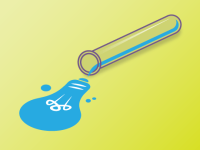Preparing for Happy Accidents
Your content has been saved!
Go to My Saved Content.What do rubber, penicillin, Teflon and Velcro have in common? They were all found by accident. This happens in science all the time -- accidents play a significant role in scientific discoveries. Some believe that nearly a third to half of all inventions were found by serendipity.
To be ready for a happy accident, you have to have what Louis Pasteur, the famous French scientist, called "a prepared mind." Discovery is about connecting the dots. It is about putting concepts together in new ways. But to do so, you must first have some comfort with the concepts so that, when something new arises, you are able to understand how you could link them together in a new way. In schools, we don't get much of this innovation time, but we should consider making some time for it so that our students can better adapt to life in the 21st century. One way of getting them to become familiar with concepts is to dissect stuff. Get a screwdriver, a broken piece of equipment and start connecting the dots.
Discovery is only possible when we're able to see things in new ways and when we remove the anchor of what was expected from what actually is. We should encourage students to be flexible in their thinking. It has been said that students who are anchored to expected results may lose patience and the opportunity to discover something new. Discovery is the art of recognizing potential. Sitting in front of the unknown is a difficult thing to do. Most people avoid it. Those in STEM fields face this every day. Success comes from learning that this is the place of innovation and not to be afraid of it.
Serendipity: A Personal Story
A toy inspired one of my inventions. When I was younger, I enjoyed a toy called "Wooly Willy" -- a blank face with iron filings that you could move with a magnet to create features like a mustache, beard or hair. I loved Wooly Willy. Fast-forward three decades, and I am a professor with students working in my lab. One of my students is adding iron filings to solder (a metal glue) as a way to strengthen it. My student notices that the solder can be picked up with a magnet and brings it to me. Instantly, Wooly Willy comes back to me, and I wonder if we could change the shape of the solder when it's a molten liquid. With the enthusiasm of seven-year-olds, we find that we can change its shape. We also find a way to make 3D shapes for electronics. Had I never spent time playing with Wooly Willy, I never would have figured this out. It was a happy accident that fell upon my "prepared mind."
Serendipity Training
There has been much discussion about how to prepare a mind to be flexible and ready for a discovery. Here are some things one can consider doing:
- Expose yourself to new things. Watch lectures, go to museums and choose things that are out of your comfort zone. This will help you create new connections in your brain. The more stuff you are exposed to, the better chance you have to link things in new ways.
- Stay curious. Observe the world with a greater intensity. Ask why things work and find answers to those questions.
- Work hard. No one makes discoveries overnight. Do more. Try more. Eventually, luck will find you.
- Don't run away. When things do not work out the way they seem, perhaps you have stumbled onto a better way. Serendipity comes from the unexpected, so try to uncover what you really found.
At the entrance of Bell Labs, one of the greatest places for innovation, is a quote from Alexander G. Bell, which says:
May you have many happy accidents!
